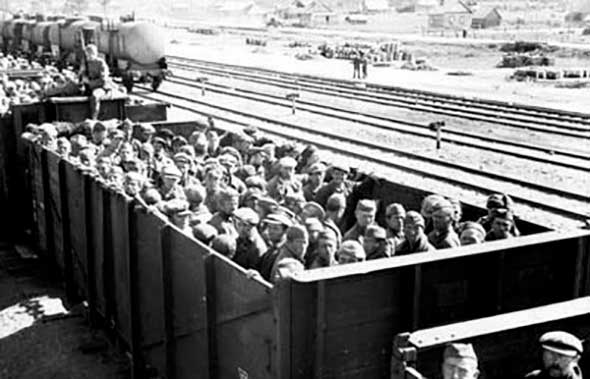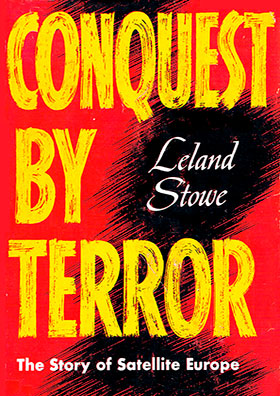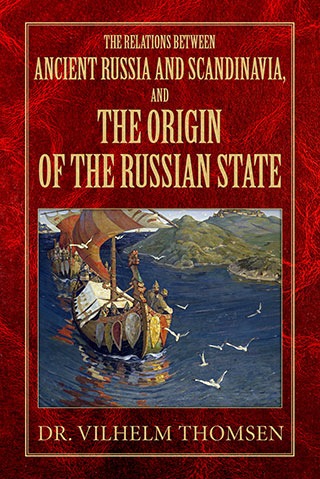Slave Labor
The Story of Satellite Europe (New York: Random House, 1952) 11,952 views
November 17, 2019

In hundreds of Red prisons and forced-labor camps throughout Eastern Europe, as in thousands of other prisons and camps throughout the Soviet Union, starvation is universal, torture a commonplace. Whole volumes could be devoted to the personal testimony of those who have miraculously survived and escaped from captive Europe. What remains truly extraordinary is the scale on which the Kremlin has exported its system of terror and torture into Eastern Europe, largely unnoticed by the press and public of the Western democracies. The free peoples remain largely ignorant of the true dimensions of Red terror in the puppet-ruled nations. The Communist inquisitors’ crimes, like the Nazis’, are so inhuman that our imaginations can scarcely grasp their enormity. But testimony by numbers of escaped prisoners has confirmed the procedures established in many widely separated Red prisons and camps. Their evidence demonstrates conclusively that identical refinements of torture, based on incomparable Soviet experience, are used by Communist interrogators in all captive countries. The Kremlin has simply extended into all of Eastern Europe its highly perfected police-torture systems, the result of thirty years’ experience in the Soviet Union.
The expansion of Communist concentration camps far exceeds that of their prisons. At least dozens—possibly scores—of new slave-labor camps are being built every year throughout captive Europe. Some of the latest are reported to be designed to confine from 20,000 to 45,000 persons. Underground reports clearly indicate that new camps, some now nearing completion, are definitely on a larger scale than earlier ones.
How many men and women are locked up in them? Up to this writing I have never seen a single newspaper survey giving a factual report on prisons and slave-labor camps in all of Eastern Europe. The true dimensions of one of history’s greatest crimes cannot be perceived by scattered, occasional news items about this or that slave camp, nor by disconnected snatches of testimony from escaped victims. But by pooling testimony from many sources it is evident that:
More than one million people are now confined in the prisons and slave camps of Eastern Europe.
This total is certainly conservative. As of May, 1951, Czech exiles in Europe and the United States had already identified 42 slave-labor camps, with approximately 200,000 occupants, in their native land. By late summer Czech underground sources placed the total at about 70 such camps, with about 30 in the region of the Jachymov uranium mines.1 Major Czech prisons are also jammed to capacity. They must account for another 50,000 to 100,000 victims.
Polish authorities in exile had identified more than 50 major camps and prisons (as of September, 1951) in which were slave laborers totaling between 400,000 and 500,000. In Rumania more than 40 slave camps are known to exist, indicating a minimum of from 300,000 to 400,000 prisoners. Between 20 and 30 major camps have been identified in both Hungary and Bulgaria, to which more than 100 prisons must be added.
In Eastern Germany the Russians and local Communists continue to operate many of the most notorious death camps founded by the Nazis. Early in 1951 a Pole was finally released from Buchenwald—the same Buchenwald whose barbarities, it was fervently hoped, would end forever with World War II. After five years of imprisonment and slave labor, the Pole reported that 10,000 persons, nearly 3,000 of them women, were still held there. “Until the end I never knew why I was kept a prisoner,” the Pole added.
From these facts it appears probable that the total number of East Europeans in slave camps and prisons may actually approach one million, as of 1952. For all of Red-ruled Europe, including Eastern Germany, at least one out of every 90 persons is locked up either in a Communist prison or a forced-labor camp. To be more accurate, however, the ratio should be based on those citizens who are twenty years of age or older. This means that one out of every 70 adult East Europeans is imprisoned by the Reds. The number of jailed and slave-labor citizens is being further increased month by month.
How the Russian system works
Production and construction by forced labor is one of Soviet Russia’s biggest businesses—a cartel for human exploitation. It is the greatest slave system ever imposed on humanity. This has been demonstrated irrefutably by masses of evidence submitted to the United Nations Economic and Social Council by its Commission of Inquiry into Forced Labor. Over a period of many years it is certain that the number of slave laborers in the Soviet Union has varied between a minimum of about eight million persons and a possible maximum of 20 million.2
 The Soviets have now exported this system into all the countries they rule. It is one of the main features of Communism. It is also an indispensable instrument of Soviet conquest, since it is an important means of getting rid of opposition. As Communism expands slave labor must—and does—expand. To understand this clearly one needs merely to examine how the system began and how it functions in the Soviet Union.
The Soviets have now exported this system into all the countries they rule. It is one of the main features of Communism. It is also an indispensable instrument of Soviet conquest, since it is an important means of getting rid of opposition. As Communism expands slave labor must—and does—expand. To understand this clearly one needs merely to examine how the system began and how it functions in the Soviet Union.
“Compulsory labor” was provided for in the very first labor code adopted by the Soviets in December, 1918. Its first article declared that all Soviet citizens, except for those under 16 and over 50, and those physically unfit, “shall be subject to compulsory labor.” In 1922 the Soviet Criminal Code frankly introduced “forced labor” as a penalty for those whose “actions are not proved to have been counterrevolutionary.” Thus the Bolsheviks have enslaved suspected opponents of their régime without trials since their first years in power.
It appears that originally “re-education through labor” was not intended to introduce a vast slave system, but it was soon brutalized by the Bolsheviks’ new “state within the state,” the G.P.U. (later renamed M.V.D.). How the Soviets’ compulsory labor evolved into the gigantic and barbarous Gulag system is told with rare clarity by Edward Crankshaw.3 The urgency demanded by the first five-year plan coincided at the end of the 1920’s with the liquidation of the kulaks, and the deportation of nearly five million peasants and their families. In 1930 the Kremlin ordered planning commissions “to incorporate the work performed by those deprived of liberty into the planned economy of the Five-Year Plan.” With that the G.P.U. established a new organization called Gulag to exploit prison labor to the utmost. Slave labor has played a major role in the Soviet economic system ever since.
By 1933 it had reached enormous dimensions, and the Soviets’ Corrective Labor Codex then replaced the term “forced labor” with the much less revealing phrase “corrective labor work.” But even the Soviet Encyclopedia of 1940 stated: “Forced labor is one of the basic measures of Soviet Socialist criminal law.”
Russia’s M.V.D. police are directly in charge of the entire slave-labor system. The M.V.D. not only operates thousands of camps, it also supplies prison labor by contract to a great variety of state industries, collectives and other enterprises. Among these are gold mining, timber cutting, fish-packing plants, railroad and highway construction, oil production and much else. An escaped former employee of the Soviet planning agency for the five-year plans has testified that, in 1939–40, the M.V.D. slave-labor agencies provided 14 per cent of all capital construction in the U.S.S.R.—more than the quota for any other ministry. The M.V.D. has separate organizations for railroad building and highway maintenance by slave labor. Gulag is the agency that administers the so-called “corrective” camps where millions of prisoners are literally worked to death. Albert Konrad Herling, research director for the U.N.’s Commission of Inquiry into Forced Labor, reports authoritatively no less than 160 Gulag mining camps, 75 lumber camps, 41 factories and scores of other M.V.D. enterprises.
Soon after the end of World War II this system was extended into Eastern Europe. The Communists began by creating concentration camps, ostensibly for pro-Nazi elements and traitors. Titled aristocrats, big landowners, wealthy industrialists, judges and generals in the Iron-Curtain countries were soon added to the category of “people’s enemies.” Soon afterward came the turn of leaders of the democratic opposition parties; finally, members of the hated bourgeoisie; then anyone who aroused suspicion or envy. What to do with these increasing multitudes of “class enemies”? As in Russia, they were put to work producing for the Communist state.
The Communists turn foreign peoples into slaves.
As early as 1945 Bulgaria’s régime created, by decree, “Communities for Educational Labor.” Similar forced-labor laws were introduced gradually in each Red-ruled country. The Czechoslovakian government’s Forced Labor Camps Act of October, 1948, is typical. Under Section II any person between the ages of 18 and 60 can be branded “a threat to the building of the people’s democratic order or the economic life” by a ruling of a three-man, all-Communist commission. Without a hearing of any kind, such persons are sent into slave labor for periods ranging between three months and two years. The law’s professed aim is “to educate citizens for work as a duty to their country.”
Russia’s Gulag system has thus become an integral part of the sovietization of all Eastern Europe. Puppet-state prisoners are confined in camps identical to those in Soviet Russia—heavily guarded, encircled by barbed- and electric-wire obstacles, surrounded by watch towers with searchlights blazing all night. Hunger is used to compel prisoners to work to the limits of their endurance. Death rates are extremely high. Under M.V.D. controls hundred of thousands of East Europeans now construct five-year-plan projects designed to increase the military power of Russia.
Several recent decrees indicate the growth of the slave system. In January, 1951, a “Central Labor Office” for all satellite states was established in Prague. Each Red puppet government was instructed to report to this office the total number of persons it had available for forced labor. A Soviet representative said that various East European states might be obliged to send their quotas of prisoners to work on major projects, such as the Danube–Black Sea Canal. This launches an all-satellite slave-labor pool, controlled by Moscow.
The Communists camouflage their slave-labor system with titles intended to conceal their true purpose. A “Construction Company of the Ministry of Interior” was set up in Rumania in March, 1951, concerned with the exploitation of prison labor. A May decree reorganized this company under the even more innocuous title of “General Management of Workers’ Reserves” (the D.G.R.M.). According to this decree the D.G.R.M. “can dispose of reserve workers, skilled and unskilled, from cities as well as the countryside, as it sees fit … in accordance with the needs of the national economy.” But who are these suddenly discovered “reserve workers” in a country where a notorious labor shortage exists? The “reserve workers” are taken from lists of jailed or suspected persons, or by seizing citizens in categories marked for liquidation. The D.G.R.M., in fact, is a direct counterpart of the Soviets’ Gulag—the provider of slave labor to state and military projects. Such labor is now building:
Hundreds of military and industrial projects throughout captive Europe.
For the immediate future the five-year plans of the puppet régimes are, above all, military programs. Slave workers have already built army barracks, bases and airfields; coastal fortifications along the Baltic and the Black Sea; underground depots for arms, food and fuel and much else.
Each Communist country has large-scale projects which need slave labor for their execution. Hungary’s gigantic ironworks at Dunapentele requires many thousands. An industrial complex comparable to Pittsburgh’s is being created there from the ground up. One now being built at Kosice in Eastern Slovakia is scheduled to be even larger. Another is located in Czechoslovakia’s Ostrava region, matched by several others in Poland; camps for political prisoners supply workers for all these projects.
More than 7,000 slave prisoners work in Bulgaria’s Pernick coal mines; 3,000 more from the Cherno More camp in other coal mines. Another 2,000 are completing a dam on the Tundzha River; about 1,000 more are building the Rositza dam. At least another dozen big construction or mining operations that use slave labor could be cited in Bulgaria alone. The Danube–Black Sea Canal, designed to create a 60-mile short cut through the Danubian delta, is perhaps the largest slave-labor project in Eastern Europe. More than 40,000 prisoners are said to work there under the harshest conditions.
A reported 10,000 to 20,000 Rumanian prisoners are slaving on the big Bistritza Valley hydroelectric project. Another 3,500 work on the Argesh Canal project. Notable slave-construction programs also include Bulgaria’s Christo Botev line fortifications, the Tulcea and Sozopol submarine bases, and the Budapest subway. Probably the greatest armies of slave laborers are mobilized in the many Czech and Polish uranium mines, where as many as 150,000 have been reported by some underground sources.
This far from complete summary suffices to show how the Soviets have already built satellite slave labor into big state business. But the Kremlin’s plans envisage much greater exploitation of the Gulag system. The Soviets’ all-satellite program requires:
Bigger slave camps—for more and more East European slaves.
In every captive country Communist five-year plans include construction programs with excessively difficult deadlines in the face of acute labor shortages. This partially explains the steady building of more and larger slave camps. Through its D.G.R.M. it is estimated that Bucharest’s Red régime alone may make nearly 500,000 additional prisoners available for slave-labor enterprises within another two or three years.
What the free world must somehow comprehend is this: In Eastern Europe the Communists hold in their power several million candidates for slavery. The better-off independent farmers and middle-class citizens listed as “suspect” for various reasons run into millions. Hundreds of thousands of workers, increasingly resentful of brutal work quotas and intolerable conditions, may eventually be accused of sabotage and deported for “re-education.” 4 Until vast numbers of these unreconstructible people have been put behind barbed wire the men in the Kremlin will fear that Communist control of the “colonial” states remains inadequate. Eastern Europe can only be rendered “secure,” by Soviet definition, through expansion of the slave-labor system. It is therefore conceivable that the Reds’ slaves in captive Europe may total two or three million persons by 1954. The Stalinists are already using these countries as a new slave-labor pool for Soviet Russia itself. This is being accomplished through:
The slave-train route into Russia and Siberia.
Tens of thousands of East European political prisoners are now being sent to Soviet slave camps on a regular schedule. At the end of World War II the Soviets shipped several hundreds of thousands of persons into Russia from concentration camps in the “liberated” countries. They were Germans, Russians, Ukrainians, Balts, Poles and also satellite citizens of German descent. These war-vengeance deportations seemed to conclude Moscow’s Gulag-recruitment program in the Iron-Curtain regions until 1950. Then the Russians secretly inaugurated “transfers” of East European political prisoners into the U.S.S.R.—a new device to reduce the Soviet Union’s labor shortage. Thanks to the changing of the Trans-Carpathian railroad lines to Russian broad-gauge, the operation was greatly simplified. A regular Soviet slave-train route has now functioned through the Carpathians since early 1951, if not before then.
Approximately 50,000 Hungarian prisoners were shipped off to Soviet slave camps during 1950, along with unknown thousands from the other puppet-ruled nations. These “transfers” continue to operate on a fixed Red timetable. Every week one or two trainloads of satellite prisoners are dispatched from Uzhorod in western Trans-Carpathia. Their occupants are destined for Soviet Gulag camps, which the great majority cannot survive. A few thousand Rumanian soldiers, held as war prisoners in the Soviet Union since 1945, were at last returned home—more skeletons than men—in the late summer of 1951. They stated that between 80 and 90 per cent of their fellow-prisoners—more than 200,000 Rumanians—had died in Russian camps. Death is the true destination of the Soviets’ new slave trains.
Uzhorod (formerly Ungvar), an important rail junction just east of the Hungarian border, with direct connections to Poland, Czechoslovakia and Rumania, serves as the chief collection point for satellite deportees. The Reds’ secret police select for shipment those prisoners with longer sentences, those regarded as most untrustworthy, or those who are particularly hated. Deportation is thus a means of vengeance; it also removes persons who might be capable of leadership. In the single month of March, 1951, some 17,000 Hungarians were gathered in Uzhorod for deportation to Russia.
How does the slave-train route to Russia operate?
The prisoners have no possible escape except death. The once Polish, now Russian city of Lwow constitutes the point of no return. In fact, I have learned of only a single prisoner who reached Lwow, yet somehow managed to be released. He got back to Hungary and finally escaped to Western Europe with a unique account of what the Soviet death-camp trains are like.
“We were transferred by night to the main Budapest prison, which is entirely run by Russian M.V.D. officials. They also brought in several hundred prisoners from Austria. We were all given Russian prison uniforms. In that way we would always be taken for Russians by anyone who might see us entraining or en route. Then they jammed us into freight cars—as many as could be forced inside standing up—and the cars were sealed. All the time we were in the cars they gave us no food or water. By the day we reached Uzhorod we were half-crazed from thirst. The air inside the cars was almost unbreathable. In two days and nights the mixed odors of vomit, defecation and urine under such conditions cannot be imagined. Even the misery and hunger of the Uzhorod camp was a relief.
“Two long trains of prisoners leave Uzhorod each week—but for what destination we did not know. The M.V.D. packed the cars with Hungarians, Czechs, Poles or Rumanians. After a week my turn came. Again we were locked up in unheated, sealed cars. It was mid-winter and frightfully cold. This time the journey was indescribable. It was much longer. The trains crawled and then stopped for long periods. But they never let us out. Some prisoners went mad from thirst. Whenever the train stopped shrieks and cries burst out on all sides: ‘Water! Water! In God’s name, water! … We are dying! … Mercy!’ The guards pounded the sides of the cars with their rifle butts and threatened to shoot. Or they paid no attention.
“When we reached Lwow at last we fell out of the doors. Few of us could stand. We were beaten and pulled to our feet. I saw the guards drag several corpses from the freight cars. We had been pressed so tightly together that men gasped their last breath, but they were kept erect by their neighbors, who did not even realize they were dead. Their bodies froze in these cramped, erect positions. Many prisoners emerged raving like madmen, and some never recovered their senses. Others were so ill that they died during the next few days.
“Lwow is the big collecting point for all East Europeans who are being sent into Russia for slave labor. A steady stream of shipments goes east, but there are always 10,000 or more in this camp. The conditions were almost as terrible as on the trains. In the coldest days of winter we were pushed into damp cellars, without heat, with almost no coverings. They gave us only thin soup and bread of the worst quality. Nearly everyone suffered from scurvy and dysentery. Lice and bedbugs spread disease everywhere. But there were no doctors—not even for the dying.
“On the slightest excuse the Russian guards beat prisoners brutally. The camp’s only law is the law of the fist and rifle butt. People were dying, day and night. The death rate was very high. But the Russians were sending an average of 2,000 prisoners each week. At that time they were all being sent to the infamous Gulag camps in the Komsomolskjaer region. Some of the Lwow camp employees admitted that 15 to 20 per cent of the prisoners died en route. That means between 300 and 400 out of each 2,000 dispatched eastward from Lwow by train.
“When a prisoner reaches Lwow he has no hope of ever being free again; no real hope even of remaining alive. I was ill and I had also lost all hope. Then something happened like an intervention by God. I can’t tell how it happened, and how it finally enabled me to return to Hungary. Someone else may possibly be saved through the same kind of miraculous accident. But until now I have never heard of anyone else who has come back.”
During 1951 more than 100,000 men, women and children were evicted from Yugoslav border regions in Bulgaria, Rumania and Hungary, and also from major Hungarian, Czech and Polish cities. Great numbers of these evacuees disappeared completely, many of them undoubtedly into Russia. Does Moscow plan to maintain and increase its “importations” of slave labor from the Iron-Curtain countries? It would be logical to expect this. The Gulag system literally devours its victims. Its slave-labor enterprises multiply. Its corpses also multiply. The Red state can never get enough slaves to supply the mounting needs of the five-year plans in the puppet states as well as in the Soviet Union.
The “class-enemy” and “political-reliability” motives for enslavement are even more compelling than the economic. Actually all three compulsions are inherent in the Soviet system. The Communist state cannot avoid wholesale enslavement because it is enslavement, per se. The Kremlin itself is exactly what its frowning, barricaded exterior indicates—a citadel of fear. In all of captive Europe Stalin and his Politburo fear vast proportions of the population with an intense, irremediable fear—because they are profoundly, unalterably anti-Communist. Thus, slave labor is not only an indispensable Soviet means of production; it is an equally irreplaceable means of reducing so-called “class enemies” either to skeletonized human wrecks—or to corpses. The world’s greatest numerical assemblage of armed manpower—unprecedented in magnitude in all history—is still not enough to provide the fear-haunted men in the Kremlin with “security.” They still endeavor to build security on mass enslavement and human bones.
In reality the establishment of a vast Communist slave-labor system throughout Eastern Europe is a warning to every citizen in the free world, most of all in the Atlantic community of nations. By this policy the Kremlin has proved that the Soviet-style state, the Red system, must create and expand slavery wherever Communism wins power. Without forcing large proportions of any country’s population into slave labor the Communists cannot hold power. Under a Red régime every person becomes some category of a slave—including the master-slaves who are members of the party. Only the Great Slave-Driver remains relatively or temporarily immune. But suspected people and potential rallying points of resistance must be beaten down into the lowest human denominator—the absolute slaves. These are the slave laborers—millions today and millions more tomorrow. Nowhere in the world are there so many candidates for future Communist slave camps as in the advanced, predominantly middle-class populations of the Western democracies. That is a fact which it might be realistic to keep in mind. The chances are roughly fifty thousand to one that you belong on the Reds’ lists of these “assured future candidates.” Eastern Europe is only a first step, the prelude.
It is one thing, of course, to recognize that the average Western citizen is the perfect candidate for labor slavery under a Communist régime. But how far would the Stalinists dare to go? They are already answering that question in every Red-ruled nation in Eastern Europe. They are preparing to make the answer more devastatingly emphatic with each passing year. The Great Slave-Maker himself has given the most cynically frank answer which it is possible to imagine.
In the early postwar period Stalin once spoke glowingly to Stanislaw Mikolajczyk, then a leader in the Polish government, about a great Slav empire stretching from the Pacific shores of Siberia through Russia up to the mid-European fringes of the Iron Curtain. Mr. Mikolajczyk pointed out that the Hungarians, after all, are not Slavs. The Hungarians, he said, would resist being swallowed up in this fashion by every means in their power.
Stalin replied with calm, arctic assurance: “The Hungarian problem is only a matter of box-cars.”
When the rulers of the Kremlin are prepared to deport the majority of 9.5 million Hungarians in sealed box-cars, why should we imagine that Communists would hesitate to treat several times that number of Western Europeans, Britishers, Americans and other capitalistic peoples in similar fashion? In its first stage Stalin’s “box-car” solution for Hungary is already under way. It is also under way in five other East European countries. The methods become amazingly efficient as the Red slave empire expands.
footnotes
1. Among the prominent Jachymov slave camps are those known as Bratrstvi I, Svornost, Marianka, Elias I and II, Svatopluk, Prokop, Loznice, Krasno, Barbora or Vrsky, Nikola, Ostrov and Vikanov. Slave camps for Czech women include those at Plzen, Stod, Jaroslavice, Ceske Budejovice and near Pardubice.
2. Albert Konrad Herling, The Soviet Slave Empire. New York: Wilfred Funk, 1951
3. Edward Crankshaw, Cracks in the Kremlin Wall. New York: Viking Press, 1951, pp. 207–223.
4. These same “irresistible pressures” are cogently summarized by Edward Crankshaw in Cracks in the Kremlin Wall, (p. 220). “The counterrevolutionary opposition had to be coralled off and set to work. …” (His reference throughout is to the original slave system’s development in Soviet Russia.) “The apathetic … land-seeking masses had to be terrorized and coerced; industrialization had to be forced through at a breakneck pace … everyone who stood in the way … above all, the peasants resisting collectivization, had to be removed … the obvious organization to carry out these projects was the G.P.U., which thus developed a vested interest in prison labor. … Add to these pressures the insecurity of an unpopular régime.”
All of these pressures now impel the Kremlin to expand the slave-labor system in Eastern Europe. At the time he wrote, Mr. Crankshaw was apparently not informed of the surprising growth of slave camps in the puppet states. He added that “With the Russification of the Baltic States the M.V.D. exhausted its last major source of slave labor.” Actually, as evidence emerging since then demonstrates, the M.V.D. has taken over a far greater source of slave labor in the populous Iron-Curtain countries.
Digital discoveries
- Casino Non AAMS
- Siti Casino
- Sites De Paris Sportifs Belgique
- Tous Les Sites De Paris Sportifs Belgique
- I Migliori Casino Online
- Non Aams Casino
- Migliori Casino Online Esteri
- Paris Sportif Crypto Sans Kyc
- Paris Sportif Ufc
- Casino Live En Ligne Français
- Site De Paris Sportifs
- Meilleurs Nouveaux Casinos En Ligne
- Casino En Ligne Français
- Casino En Ligne
- Casino Retrait Instantané








